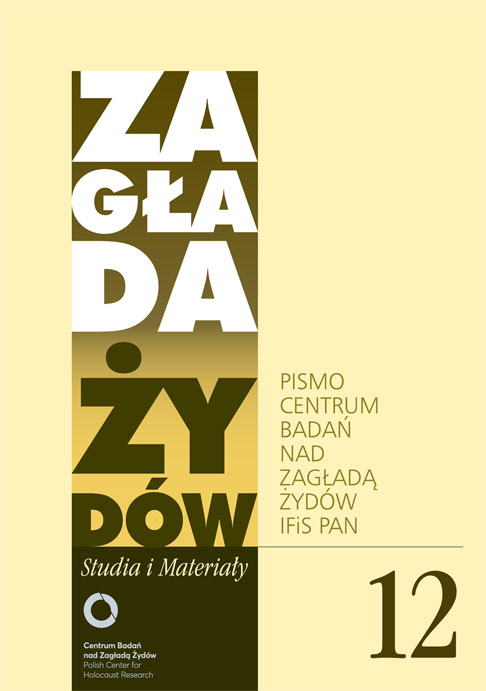Społeczeństwo holenderskie i los Żydów: skomplikowana historia
Zagłada Żydów. Studia i Materiały, Nr 12 (2016), Strony: 425-434
Data zgłoszenia: 2020-10-20Data publikacji: 2016-11-30
 https://doi.org/10.32927/ZZSiM.426
https://doi.org/10.32927/ZZSiM.426
Abstrakt
The percentage of victimization of Dutch Jewry during the Shoah is the highest of Western, Central and Southern Europe (except, perhaps of Greece), and close to the Polish one: 75%, more than 104.000 souls. The question of disproportion between the apparent favorable status of the Jews in society – they had acquired emancipation in 1796 - and the disastrous outcome of the Nazi occupation as compared to other countries in general and Western European in particular has haunted Dutch historiography of the Shoah. Who should be blamed for that outcome: the perpetrators, i.e. the Germans, the bystanders, i.e. the Dutch or the victims, i.e. the Dutch Jews? The article first surveys the answers given to this question since the beginnings of Dutch Holocaust historiography in the immediate post-war period until the debates of today and the factors that influenced the shaping of some basic perceptions on “Dutch society and the Jews”. It then proceeds to detailing several facts from the Holocaust period that are essential for an evaluation of gentile attitudes. The article concludes with the observation that – in spite of ongoing debates – the overall picture which has accumulated after decades of research will not essentially being altered. Although the Holocaust was initiated, planned and carried out from Berlin, and although a considerable number of Dutchmen helped and hid Jews and the majority definitely despised the Germans, considerable parts of Dutch society contributed to the disastrous outcome of the Jewish lot in the Netherlands – through a high amount of servility towards the German authorities, through indifference when Jewish fellow-citizens were persecuted, through economically benefiting from the persecution and from the disappearance of Jewish neighbors, and through actual collaboration (stemming from a variety of reasons). Consequently, the picture of the Holocaust in the Netherlands is multi-dimensional, but altogether puzzling and not favorable.
Słowa kluczowe
społeczeństwo holenderskie wobec Żydów , literatura o Zagładzie w Holandii
Licencja
Prawa autorskie (c) 2016 Autor & "Zagłada Żydów. Studia i Materiały"

Utwór dostępny jest na licencji Creative Commons Uznanie autorstwa 4.0 Międzynarodowe.
https://creativecommons.org/licenses/by/4.0
Inne teksty tego samego autora
- Avner Shalev, Dan Michman, David Silberklang, Ścisła pamięć o Zagładzie w Muzeum Historii Holokaustu w Yad Vashem. Odpowiedź na artykuł Amosa Goldberga , Zagłada Żydów. Studia i Materiały: Nr 7 (2011)
Podobne artykuły
- Anna Ziółkowska, Medycyna obozowa. O tym jak chorowali, cierpieli i umierali żydowscy robotnicy w obozach pracy przymusowej w Poznaniu (1941–1943) , Zagłada Żydów. Studia i Materiały: Nr 8 (2012)
- Jacek Leociak, Anna Ziębińska-Witek, Historia w muzeach. Studium ekspozycji Holokaustu , Zagłada Żydów. Studia i Materiały: Nr 9 (2013)
- Bartłomiej Krupa, Critical History and its ‘Shadow Cabinet’. Polish Historiography and the Holocaust during 2003–2013 , Zagłada Żydów. Studia i Materiały: Nr Holocaust Studies and Materials (2017)
- Ewa Koźmińska-Frejlak, „Idę do pieca, ponieważ nie chciałam mu dać siebie”. Akta Sądu Społecznego przy Centralnym Komitecie Żydów w Polsce. Próba lektury genderowej , Zagłada Żydów. Studia i Materiały: Nr 19 (2023)
- Bożena Szaynok, Zatrzymane w archiwach. Wojewódzki Urząd Kontroli Prasy, Publikacji i Widowisk w Poznaniu wobec tematyki żydowskiej na łamach czasopism katolickich (1945–1950) , Zagłada Żydów. Studia i Materiały: Nr 15 (2019)
- Joanna Król, „Podczas wojny przebywał w łódzkim getcie”. Portret architekta Ignacego Gutmana , Zagłada Żydów. Studia i Materiały: Nr 16 (2020)
- Helena Datner, Marta Janczewska, Jacek Leociak, Archiwum Ringelbluma. Antologia , Zagłada Żydów. Studia i Materiały: Nr 16 (2020)
- Bożena Szaynok, „Tuż po Zagładzie”. Kościół wobec problematyki żydowskiej (VII 1944–VII 1946) , Zagłada Żydów. Studia i Materiały: Nr 5 (2009)
- Jacek Leociak, Ruta Sakowska (1922–2011) , Zagłada Żydów. Studia i Materiały: Nr 7 (2011)
- Tomasz Frydel, Zwykła organizacja, nadzwyczajna przemoc państwowa. Polska policja granatowa a Zagłada we wschodniej części dystryktu krakowskiego , Zagłada Żydów. Studia i Materiały: Nr 17 (2021)
<< < 1 2 3 4 5 6 7 8 9 10 11 12 13 14 15 16 17 18 19 20 21 22 23 24 25 26 27 28 29 30 31 32 33 34 35 36 37 38 39 40 41 42 43 44 45 46 47 48 49 50 > >>
Możesz również Rozpocznij zaawansowane wyszukiwanie podobieństw dla tego artykułu.
 English
English
 Język Polski
Język Polski



 https://orcid.org/0000-0001-7496-496X
https://orcid.org/0000-0001-7496-496X





